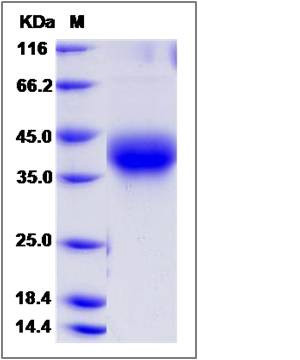Rhesus CLEC5A / MDL1 / MDL-1 Protein (His Tag)
CLEC5A
- 100ug (NPP2896) Please inquiry
| Catalog Number | P90157-C07H |
|---|---|
| Organism Species | Rhesus |
| Host | Human Cells |
| Synonyms | CLEC5A |
| Molecular Weight | The recombinant rhesus CLEC5A comprises 181 amino acids and has a calculated molecular mass of 21 KDa.. |
| predicted N | His |
| SDS-PAGE |  |
| Purity | > 95 % as determined by SDS-PAGE |
| Protein Construction | A DNA sequence encoding the rhesus CLEC5A (XP_001085243.1) (Pro28-Arg188) was expressed with a polyhistide tag at the N-terminus. |
| Bio-activity | |
| Research Area | Cancer |Signal transduction |Cytoskeleton / ECM |Cell Adhesion |Lectin |C-tyep lectin | |
| Formulation | Lyophilized from sterile PBS, pH 7.4. 1. Normally 5 % - 8 % trehalose and mannitol are added as protectants before lyophilization. Specific concentrations are included in the hardcopy of COA. |
| Background | CLEC5A, also known as MDL1 and MDL-1, is a member of the C-type lectin/C-type lectin-like domain (CTL/CTLD) superfamily. Members of this family share a common protein fold and have diverse functions, such as cell adhesion, cell-cell signalling, glycoprotein turnover, and roles in inflammation and immune response. CLEC5A with dnax-activation protein 12 and may play a role in cell activation. It also functions as a positive regulator of osteoclastogenesis. CLEC5A acts as a key regulator of synovial injury and bone erosion during autoimmune joint inflammation .The binding of dengue virus to CLEC5A triggers signaling through the phosphylation of TYROBP, this interaction does not result in viral entry, but stimulates proinflammatory cytokine release. |
| Reference |
